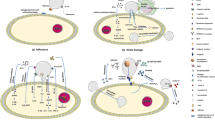Abstract
Associated with a significant morbidity and mortality, neurocandidiasis affects severely immunocompromised patients, especially if recently treated with antibiotics or corticosteroids. We present the case of a 70-year-old man admitted to an intensive care unit due to a Sars-Cov-2 pneumonia, with fever, coma, and multifocal neurological deficits reported 13 days after extubation. After isolation of Candida albicans in both urine and blood cultures and a brain MRI with multiple gadolinium-enhanced ring lesions, a diagnosis of neurocandidiasis was assumed and aggressive antifungal therapy started. During treatment, the patient developed a hospital-acquired pneumonia with fatal outcome.
Similar content being viewed by others
A previously autonomous 70-year-old man with diabetes mellitus was admitted to an intensive care unit due to a SARS-CoV-2 pneumonia, where both central venous and urinary catheters were placed. After treatment with remdesivir, piperacillin-tazobactam, and a 15-day course of dexamethasone 6 mg, the patient was successfully extubated. Thirteen days later, fever and unconsciousness were reported. At observation by Neurology, the patient was unresponsive, with a right flaccid and left spastic hemiplegia, bilateral Babinski sign, and preserved brainstem reflexes. Urine and blood cultures were ordered, with isolation of Candida albicans in both samples. Cerebrospinal fluid analysis was unremarkable, including a negative mycologic culture. An MRI revealed multiple small gadolinium-enhancing ring lesions, with cortical-subcortical and basal ganglia dispersion, suggestive of neurocandidiasis microabcesses (Fig. 1 (1-8). No signs of endophthalmitis were found, and a transesophageal echocardiogram ruled out infective endocarditis. The patient was placed on fluconazole at 400 mg bid (for 26 days), flucytosine at 1000 mg bid (for 30 days), voriconazole 200 mg bid (for 6 days), and anidulafungin 70 mg daily (for 4 days). However, during clinical admission, the patient developed Klebsiella pneumoniae and Pseudomonas aeruginosa pneumonia, leading to type 2 respiratory failure, culminating in the patient’s death.
Multiple small gadolinium-enhancing ring lesions, with cortical-subcortical and basal ganglia dispersion, suggestive of neurocandidiasis microabcesses. (1) Axial T2w. (2) Coronal T2w. (3) Sagittal T2w. (4) Axial T2*w gradient echo. (5) DWI. (6) ADC. (7, 8) Gadolinium-enhanced T1w, axial and coronal, respectively
Associated with significant morbidity and mortality [1], neurocandidiasis affects severely immunocompromised patients, especially with insertion of central venous catheters (CVC) or recent treatment with antibiotics or corticosteroids [1].
Typically found in septic patients in the setting of intensive care units, patients most frequently present a diffuse encephalopathy with a decreased level of consciousness [2], commonly overlooked due to the severity of the patient’s clinical condition. Rare descriptions of focal and fluctuating neurological deficits have been reported.
Gadolinium-enhanced cerebral microabcesses are the most frequent pathological findings reported in these patients [2], found spread in the central nervous system, with usual involvement of the basal ganglia and cerebellum. Notwithstanding, macroabscesses, strokes due to vasculitis or mycotic aneurysms, and candida leptomeningitis have also been described.
With diameters inferior to 3 mm, cerebral microabcesses are usually below the resolution capacity of the cerebral computed tomography, rendering this exam useless in the diagnosis of neurocandidiasis [2]. Lumbar punctures are also not diagnostic, since the culture of cerebrospinal fluid is sterile in most cases. Isolation of Candida species in blood cultures indicates invasive candidiasis, supporting the diagnosis [2]. Brain tissue biopsy has proven accurate in diagnosing neurocandidiasis when CSF and blood cultures are unremarkable [1].
Current guidelines recommend initial treatment with IV amphotericin B with optional addition of 5-flucytosine for several weeks, followed by fluconazole daily, until complete clinical, laboratorial, and radiological resolution [1].
Despite COVID-19 immune dysregulation, no significant cellular immune defects vital for Candida spp. immunity have been reported, thus suggesting that these invasive infections may, in fact, result from prolonged ICU admissions, CVC, or broad-spectrum antibiotic usage [3].
Data availability
Not applicable.
Code availability
Not applicable.
References
Fennelly AM, Slenker AK, Murphy LC, Moussouttas M, DeSimone JA (2013) Candida cerebral abscesses: a case report and review of the literature. Med Mycol 51(7):779–84. https://doi.org/10.3109/13693786.2013.789566
Sánchez-Portocarrero J, Pérez-Cecilia E, Corral O, Romero-Vivas J, Picazo JJ (2000) The central nervous system and infection by Candida species. Diagn Microbiol Infect Dis 37(3):169–179. https://doi.org/10.1016/s0732-8893(00)00140-1
Arastehfar A, Carvalho A, Nguyen MH, Hedayati MT, Netea MG, Perlin DS, Hoenigl M (2020) COVID-19-associated Candidiasis (CAC): an underestimated complication in the absence of immunological predispositions? J Fungi 6(4):211. https://doi.org/10.3390/jof6040211
Author information
Authors and Affiliations
Contributions
All authors contributed to the study conception and design. Material preparation, data collection, and analysis were performed by Miguel Miranda, Vera Montes, and Sandra Sousa. The first draft of the manuscript was written by Miguel Miranda, and all authors commented on previous versions of the manuscript. All authors read and approved the final manuscript.
Corresponding author
Ethics declarations
Ethical approval
Case submission approved by the local ethics’ committee.
Informed consent
Not required. Information anonymized.
Conflict of interest
The authors declare no competing interests.
Additional information
Publisher's note
Springer Nature remains neutral with regard to jurisdictional claims in published maps and institutional affiliations.
Rights and permissions
About this article
Cite this article
Miranda, M.A., Sousa, S.C. & Montes, V.L. Post-COVID-19 neurocandidiasis. Neurol Sci 42, 4419–4420 (2021). https://doi.org/10.1007/s10072-021-05515-5
Received:
Accepted:
Published:
Issue Date:
DOI: https://doi.org/10.1007/s10072-021-05515-5





